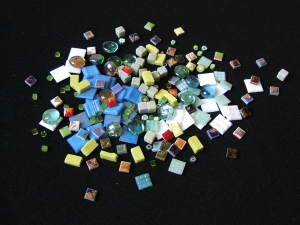Teaching Art
Not only am I having my first experiences teaching adults, but I’m also brand-new to teaching art. I have had decades to practice art, to experience being a student, and to think about the many subjects within the category ‘art’, but teaching is a novelty for me.
After seeing the first day’s tangible results of the various ways of thinking and making among the students, I struggled to come up with one concept for the second day’s class that would speak to each person there. I do not have any evidence one way or the other that I hit the mark, but my statement did lead to an open discussion about what each student’s experience had been during the first day. Below is my statement, more or less.
 Pile of tesserae, both glass and ceramic
Pile of tesserae, both glass and ceramic
The job of the artist or craftsperson is to train her materials to possess self-control. This is accomplished through hours of practice and focus. Once the materials are under control, they are coherent, understandable. When the material is coherent, the artist can start to understand it when it speaks. When the artist listens to the material and considers its point of view, as well as his own, a dialogue has begun. This dialogue can be observed by anyone with whom the artist/craftsperson cares to share his works.
Too much control by the artist squashes the initiative of the material, and it remains mute, a silent and, perhaps, unwilling partner in the effort to make art live.
Too little control by the artist, and the materials are always getting the upper hand; like children, they believe they want complete autonomy, but when they gain it, they are insecure and act out in all kinds of unexpected and embarrassing ways.
The life of an artist or craftsperson is much like the life of a parent, always training and being trained, searching for a harmonious balance between give and take, trying not to undermine or be undermined.
